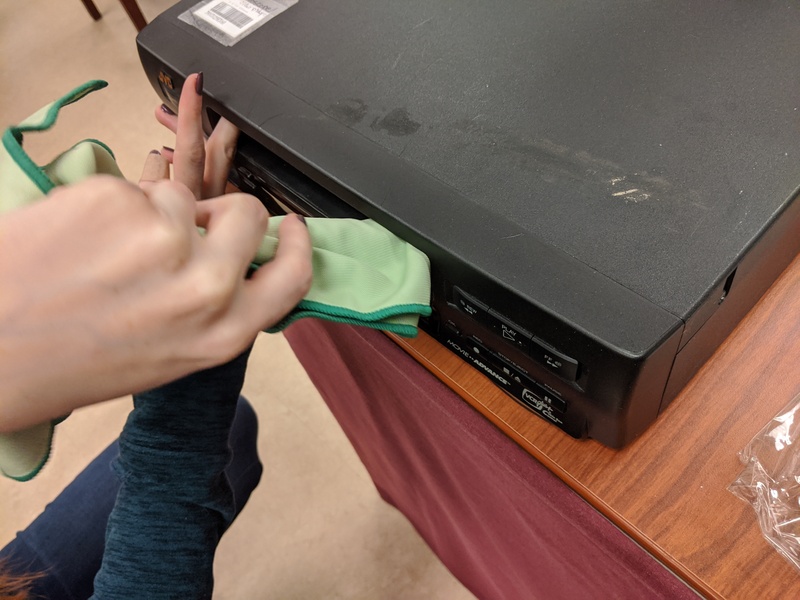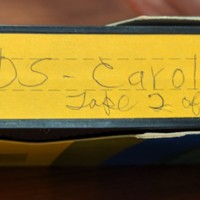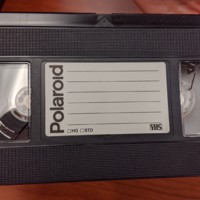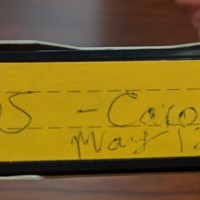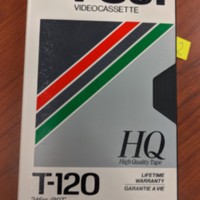VHS Digitization Process
For more information and details on the analog-to-digital digitization steps for VHS, please consult our User-Friendly Digitization and Preservation Guide.
Our digitization process for our went very smoothly. ARCS already owned the equipment required:
- A PC with a monitor
- A prosumer VCR (JVC Pro-Cision 90u Head), which includes a Time Base Corrector
- A digitization device (Diamond Multimedia One-Touch Video Capture VC5000)
- Component cables to connect the digitization device, the VCR, and the computer
- An external hard-drive
Once we arrived, the equipment was already correctly set up and wired. We first evaluated the VCR; as it was dusty, Amanda cleaned it with small cleaning tools provided by Marina.
We then evaluated our two VHS tapes. They were free of dust, did not smell bad, were not cracked, did not have peeling labels, had tightly wound magnetic tape, did not make unusual sounds when shaken (to check if there are loose pieces), and had been out in the room for a while (thus were the same temperature as the room). We took three (3) pictures of each tape: their case, their side label, and the front of the VHS (in this case, neither tape had information written on the front label).
We started our digitization with Tape 1 of 2; we first fast forwarded to the end of the tape and then rewound it. We opened EZGrabber on the connected computer and modified the settings by changing the video input to "Composite" (which allowed us to see what the VCR was capturing), and changing the Record Format to "DVD" (the highest quality available given the equipment and requested by Marina). We played the video for a few minutes to ensure there were no issues, then rewound and recorded a test file with the first few minutes of the VHS. We rewound the tape again and started our real recording with EZGrabber, recording for 3 seconds prior to pressing "Play" on the VCR in order to give the file a small buffer without having to edit it afterwards (this prevents the video from starting suddenly as soon as a user presses "play"). We followed the same steps for the second tape.
After recording, we went back to our digitized files in order to add to our metadata. First, we kept a close eye on the first tape's video and took screenshots of the agenda used for the subjects' meeting. We then listened to several portions a few times to compare our results with what the subjects were saying orally. In addition, we found the section of the video where the subjects did a round table and listened several times in order to get as many names as possible. To verify our findings, we went through some photographs from the Ashley Turner fonds and tried to find subjects of the video in the labeled pictures. We found several of the women's last names this way, as well as some of the spellings for their names. The information we found was put into two .txt files (one for Part 1 of 2 and one for Part 2 of 2).
To finish up, we entered our metadata (Dublin Core) in an Excel document for each of the elements we would give to ARCS:
- Digitized Tape 1 of 2 (MPG)
- Digitized Tape 2 of 2 (MPG)
- Sreenshot of the Agenda 1 (JPG)
- Screenshot of the Agenda 2 (JPG)
- Picture of Tape 1 of 2 - front (JPG)
- Picture of Tape 1 of 2 - side label (JPG)
- Picture of Tape 1 of 2 - case (JPG)
- Picture of Tape 2 of 2 - front (JPG)
- Picture of Tape 2 of 2 - side label (JPG)
- Picture of Tape 2 of 2 - case (JPG)
- Additional metadata for Tape 1 of 2 (subjects, typed agenda, etc.) (.txt)
- Additional metadata for Tape 2 of 2 (subjects, typed agenda, etc.) (.txt)

